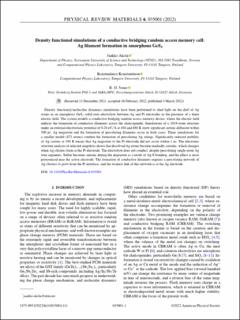| dc.contributor.author | Akola, Jaakko | |
| dc.contributor.author | Konstantinou, Konstantinos | |
| dc.contributor.author | Jones, R.O. | |
| dc.date.accessioned | 2023-03-07T08:10:32Z | |
| dc.date.available | 2023-03-07T08:10:32Z | |
| dc.date.created | 2022-04-06T18:53:25Z | |
| dc.date.issued | 2022 | |
| dc.identifier.citation | PHYSICAL REVIEW MATERIALS. 2022, 6 (3), . | en_US |
| dc.identifier.issn | 2475-9953 | |
| dc.identifier.uri | https://hdl.handle.net/11250/3056211 | |
| dc.description.abstract | Density functional/molecular dynamics simulations have been performed to shed light on the drift of Ag atoms in an amorphous
Ge
S
2
solid-state electrolyte between Ag and Pt electrodes in the presence of a finite electric field. The system models a conductive bridging random access memory device, where the electric field induces the formation of conductive filaments across the chalcogenide. Simulations of a 1019-atom structure under an external electrostatic potential of 0.20 eV/Å at 480 and 680 K show significant atomic diffusion within 500 ps. Ag migration and the formation of percolating filaments occur in both cases. Three simulations for a smaller model (472 atoms) confirm the formation of percolating Ag strings. Significantly reduced mobility of Ag cations at 380 K means that Ag migration to the Pt electrode did not occur within 1 ns. The electronic structure analysis of selected snapshots shows that dissolved Ag atoms become markedly cationic, which changes when Ag clusters form at the Pt electrode. The electrolyte does not conduct, despite percolating single-atom Ag wire segments. Sulfur becomes anionic during the migration as a result of Ag-S bonding, and the effect is most pronounced near the active electrode. The formation of conductive filaments requires a percolating network of Ag clusters to grow from the Pt interface, and the weakest link of this network is at the Ag electrode. | en_US |
| dc.language.iso | eng | en_US |
| dc.publisher | American Physical Society | en_US |
| dc.title | Density functional simulations of a conductive bridging random access memory cell: Ag filament formation in amorphous GeS2 | en_US |
| dc.title.alternative | Density functional simulations of a conductive bridging random access memory cell: Ag filament formation in amorphous GeS2 | en_US |
| dc.type | Peer reviewed | en_US |
| dc.type | Journal article | en_US |
| dc.description.version | publishedVersion | en_US |
| dc.rights.holder | ©2022 American Physical Society | en_US |
| dc.source.pagenumber | 11 | en_US |
| dc.source.volume | 6 | en_US |
| dc.source.journal | PHYSICAL REVIEW MATERIALS | en_US |
| dc.source.issue | 3 | en_US |
| dc.identifier.doi | 10.1103/PhysRevMaterials.6.035001 | |
| dc.identifier.cristin | 2015762 | |
| cristin.ispublished | true | |
| cristin.fulltext | postprint | |
| cristin.qualitycode | 1 | |
